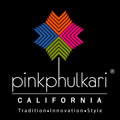Vintage Phulkari Khaddar Bagh - A Perfect Piece Of Art
Phulkari Khaddar Bagh Vintage handwork embroidery from Punjab, India Early 20th century. The word Phulkari literally means “flower-embroidery”. The art of Phulkari originated in 15th century AD in Punjab, a north Indian state in India. Most of the women in small towns and villages are busy creating amazing Phulkari shawls, dupattas and other hand woven garments. Phulkari embroidery is basically done on cotton or khaddar material. Decorative pieces are used as shawls and dupattas that cover head whereas Bagh is created on the garment that covers the whole body. Today Phulkari has become an integral part of day today life of women in Punjab.
The embroidery is very simple but the color combination, stitches and the pattern makes it look spectacular and gorgeous. It is created on fabrics like chinon silk, cotton, kota net, khaddar and is used in various ways. Today phulkari is not only seen on garments but can also be seen on bed sheets, pillow covers, curtains, wall hangings etc.
The Creation:
It is a form of traditional art where it is done in simple designs with long and short darn stitches. The shorter the stitch is the finer it looks. The art of Phulkari lies in the manipulation of patterns, colors and the length of stitches. In early days the silk thread used in embroidery was brought from Afghanistan, China and other parts of India like Kashmir and Bengal.
The Colors:
The bright colors are always preferred when it comes to Phulkari because it refers to flowers and garden. The main colors used are Yellow, red, green, orange, pink and blue. The most interesting part of phulkari is that, no different shades are used for shading purpose; rather it’s done with the horizontal, diagonal and vertical stitches. The shiny thread reflects different shades in different directions.
The fabric:
In early days the cloth used for phulkari was basically cotton and khadi which was home-spun and dyed. The tough cloth was appropriate to work without frame and was easy to maintain. The stitch counting was also easy, as the weaver has to count the stitches to maintain the symmetry. Today a variety of fabric is used in this traditional embroidery. The dupattas can vary from chiffon, Georgette and crepe.
Perfect Piece of Art:
This bagh phulkari, with its base cloth barely visible beneath the solid embroidery that covers the surface, displays a perfectly rendered pattern in multiple colors. Vintage Khaddar Bagh Phulkari embroidery was done on two smaller pieces of fabric that were then stitched together. The pattern aligns flawlessly, demonstrating the great skill of the embroiderer. A now illegible pen inscription near one corner might record the name of the embroiderer, the weaver or dyer of the cloth, or the cloth’s recipient.

Early 20th Centry Phulkari Khddar Bagh
--------
Shop our large collection of Vintage Khadar Bagh for weddings. Ready to ship from California








